
Our lunch ride is a straight shot up the Berkeley Hills. I break an early sweat on the steep beginnings of Spruce to rise above the chaos of the city below, where thoughts are crisp as air. Elle and I sync side by side, curving towards our classic selfie shot at the lookout.
I don’t remember what triggered it.
Was it emotional? Something about symbiotic leg circles and forward momentum makes our truths spill out. Perhaps our conversation hit a soft spot and sent me on a spiral.
Or was it somatic? Maybe it was the strain of my muscles, the pumping of my heart, and the gasps for air that crescendoed into overwhelm.
Living with trauma and mental injury, I’ve learned that one of my brain’s many voices is that of shame.
I feel it coming on and woosh out a quick “see you at the top.” Without a blink, Elle continues her ascent. I complete two more rotations to get me off the road. Right there, hunched over my handlebars, I hyperventilate.
My mind is a thrashing sea of anxieties. Are you serious?! What’s wrong with you? You’ve done this climb a thousand times! How long are you gonna make Elle wait at the top? Why can’t you pull it together?!
When the shame voice runs rampant, it’s as judgmental as the meanest person I’ve ever met.
My legs wobble and I dig for air, no dice. I lean sideways with my bike and slide off onto the ground, bracing my elbows on my knees as tears hit my thighs and trail towards my shorts. A voice breaks through the waves and coos that I’m okay, that Elle’s fine, that there’s nothing to be ashamed of, that I don’t need to be anywhere but here.
It took me a year of biking and a decade of healing to develop that voice.
Living with trauma and mental injury, I’ve learned that one of my brain’s many voices is that of shame. When the shame voice runs rampant, it’s as judgmental as the meanest person I’ve ever met.
Then, there’s the social shame that piles on top. The last thing I want is someone to see me in an episode and try to guide me through it. Even if they get it right, I’ll still feel awful. Awfully embarrassed. Awfully burdensome.
As an anxious biker, it can get awkward in groups where I bike noticeably slower than the rest. I’m in the back trying to keep my anxious, performance-based thoughts at bay. I’m trying not to slip into a hard place where my anxiety beckons. Friendly bikers will stop and wait, others will cheerlead me on as they push ahead — but I don’t love the attention. It feels a lot like pressure.
As I child, I was praised for my strength. You’re so strong, they said: my friends, friends’ parents, teachers, guidance counselors. It’s not praise, though, it’s pressure: pressure to continue being strong as the violence against me persisted. I resigned to the myth that the only action available to me was to tough it out. I started feeling like I couldn’t show a single weakness. I hid every sign of vulnerability. I put on my strong face. All I could do was grin and bear it.
Truth is, sometimes I don’t want to be strong. Sometimes I want to stop and catch my breath, turn around and go home, take all the time I need.
My anxiety isn’t something I can pedal off; it comes on the ride with me. So, I treat it as a companion and I tell it we’ll work together. Then, I tell my bike buddies that I’ll see them at the top.
If you bike with shame or anxiety, here are three tips to have a good ride:
1. Get in shape, not in shame
The best way to get better at biking is to bike — but the hills will feel steeper if you’re soaked in shame.
Pay attention to the ways that shame sneaks into your ride (and your life, for that matter). Your biking experience is yours to evolve. Be patient and persistent. Stop when you want to. Set goals. Celebrate your wins.
I promise that if you keep biking you will surprise yourself.
2. Set out for support
Like many outdoor activities, biking suffers from elitism. For one thing, there are socioeconomic, gender-based, and racial barriers to entry. Then, even if you break into the stratified scene, there can be a lot of performance pressure: the pressure to be fast, to know what you’re talking about, to log your rides on Strava.
The bottom line is that some riders won’t be your riders. Some are too fast and snarky. The key is to find a community that fits your style. Check out local bike organizations, bike stores, and nonprofits in your area, like this one in the Bay, that host accessible riding events.
You’ll find the speed demons — maybe you’ll even join them one day. But if you’re anxious, or you’re a beginner, find a kind community that will teach you the ropes and respects your journey.
Get a proper bike fit, ask a buddy the “stupid” questions, and find yourself an Elle who has no problem waiting at the top. Some riders cherish the extra time to peep the view!
3. Find your limits (and friends who respect them)
You’ll go on a ride that’s too big for you. A month later, that same ride will be a piece of cake. When I’m nervous about a ride, here are a few things I do to set myself up for success:
- Pre-download the maps. That way, I can tell my friends that I’ll meet them at the lunch spot, or at the top, or back at the car. I can set my own pace.
- Ask the group what type of ride they want before committing to it. For groups who are faster, I ask if they want to crank it out or have a more leisurely ride. When our riding moods match, it’s a darn good time. Plus, riding with better riders is how you level up.
- Prepare to shift out of the inner critic. The more I observe my mind chatter, the better I get at climbing out of shame spirals and taking a path of compassion with myself.
It’s worth it. Biking has endless health benefits and great views. Good rides give the best sleep, juicy writing ideas, and a restored appetite for life.








